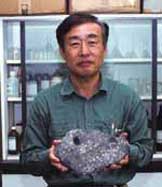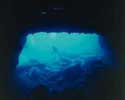|
One of the most interesting of all the features on the ‘Upper Terrace’ of the ‘No.1 Monument’ at Iseki Point is that of the ‘turtle’, which shows definite signs of having been ‘carved’ on the top part of the structure.
The depth of the ocean above the flat ‘Upper Terrace’ is usually between 15 and 30 feet, and it is this part of the terrace that sometimes emerges for brief periods above the surface of the waves.

—
Okinawa, Japan
—
the Okinawan fable of
“Urashima Taro”
– the kind fisherman –
The May 22 2000 edition of the Japanese newspaper, The Mainichi Daily News, carried an interesting feature article entitled “Legends of Okinawa”, and it told of a well known myth regarding a fisherman and a turtle, that might well throw some light on the carving of the ‘ turtle’ found on part of the upper terrace of the ‘No.1 Monument’ at Iseki Point, Yonaguni-jima.
This fable is well known to all Japanese schoolchildren, and is the story of a kind fisherman, Urashima Taro, who saved a turtle from bullies. The kind Urashima released the turtle safely into the sea, and was rewarded for his kindness by a visit from a ‘giant turtle’ who offered him a ride ‘beneath the sea’. There he is said to have met a princess who welcomed him to a ‘magical kingdom’. After a few days, Urashima decided to go back home, only to find that ‘home’ no longer existed, at which point he also realised that he had aged considerably overnight.
Some scholars maintain this fable had its roots in a Pacific culture which believed that, when islanders die, a ‘giant turtle’ would carry them to a ‘paradise beneath the sea’ where they would be welcomed by the gods. Others interpret the Okinawan fable differently, and place the story’s roots in a very much older myth about a thriving island culture that was totally destroyed overnight by a ‘natural disaster’. Well now, does that sound familiar or not?
Whatever the truth behind the ‘Urashima Taro’ legend, others who have seen the ‘turtle’ carving up close marvel at its simple beauty. Amongst the many interested people who have dived to investigate the many structures off the coast of Yonaguni-jima at Iseki Point are the photographer, Santha Faiia, and her husband, the writer and broadcaster, Graham Hancock. The image below is one that was taken by Santha Faiia in 1999, and shows the ‘turtle’ carving on the ‘No.1 Monument’ at Iseki Point from a different angle. Click on the image to go to her ‘underwater ruins’ image gallery.

Santha Faiia
—
Okinawa, Japan
—
Graham Hancock’s book, “Underworld”, has shown beyond all manner of doubt that Professor Masaaki Kimura’s 10-year dedication to unravelling the mystery of the enigmatic underwater structures in the East China Sea has been time that was certainly well spent.
In “Underworld”, Hancock also details his own search for the remains of the many civilisations that were inundated as the sea-levels rose during the end of the last Ice Age. The February/March 2002 programmes on UK Channel 4, “Flooded Kingdoms of the Ice Age”, which accompanied the release of “Underworld”, focussed on the recent discoveries that have been found in depths of up to 300 feet of water on various coastal shelves, and in shallow seas, around the world – including the Mediterranean around Malta.
Unfortunately Professor Masaaki Kimura’s books about the Iseki Point structures and other enigmas in the East China Sea and the Pacific are only available in Japanese at the moment. The titles of some of his books are:
“The Mystery of Okinawan Sea-floor Ruins”
“A Continent that Sank in the Pacific”
“‘Mu’ Continent was in Ryukyu!”
Needless to say, the English language editions are eagerly awaited …
History’s Mysteries
“Do undersea relics near Okinawa offer proof of a sophisticated civilization during the last ice age?
Archeologists have long believed that civilization as they define it — intelligent, tool-making, monument building, social humans — began about 5,000 years ago.
But submerged beneath the waves near the Japanese island of Yonaguni is evidence that may well overturn that long-held theory.
A small but persuasive number of scholars and scientists have long thought that “advanced” societies may have existed as long as 10,000 years ago.
Their theories, however well reasoned and defended, have been hamstrung by a lack of evidence..
But recent discoveries of man-made artifacts on the Pacific seafloor may well prove to be the smoking gun that will propel this alternative view of civilization to prominence”.
see the evidence with ‘unique underwater footage’
of the various Yonaguni structures in the
‘History Channel’ TV programme
“Japan’s Mysterious Pyramids”
NTSC DVD
or
VHS
|




























